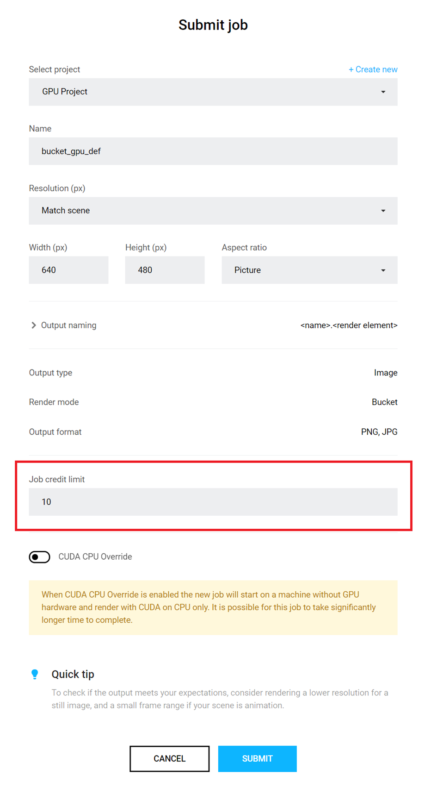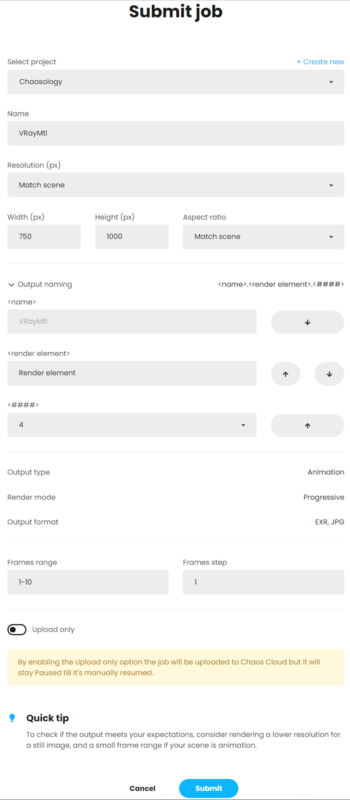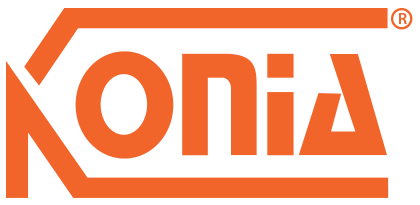Overview
You can submit render jobs to Chaos Cloud either directly from your host 3D platform through the Chaos Cloud client or manually through any command line interface.
Chaos Cloud requires the installation of the Chaos Cloud client application. For more information, see the Installation of Chaos Cloud client page.
If you add a new version of a job that you have already submitted to Chaos Cloud, its upload is much quicker than the initial upload. Chaos Cloud compares every new job to the existing ones, and if there is a match, the client app uploads only the changes. The new job data is visible only from the account it was uploaded from and does not affect the project. This is useful when you make a new iteration of an existing scene. That is why it is useful to keep your jobs in Chaos Cloud while you are still working on them.
Your Credits Balance is now displayed on each Chaos Cloud portal page. It is visible in the top right corner next to the login information.
Submitting Render Jobs Through Host Applications
Depending on the platform you use, there is a Render in Chaos Cloud button that automatically sends and loads the scene in Chaos Cloud.
Once the scene is successfully analyzed, you have to finalize some of the settings of the render job before it starts rendering in Chaos Cloud.

Submitting an animation

Submitting a still image
The output image types that you are able to download by rendering in Chaos Cloud are JPG and the file type you have specified in the settings of your scene. These settings are customized in the 3D application you use for designing your scene. If you don’t specify anything in the 3D application, Chaos Cloud generates an EXR image beside the JPG one.
When submitting a render job requesting TIFF and/or TGA images as a result, the results might be unexpected as not all TIFF and TGA settings are exported to Chaos Cloud.
Note that the supported output image formats by Chaos Cloud regardless of the host application are the following: *.png, *.bmp, *.tga, *.hdr, *.sgi, *.rgb, *.rgba, *.jpg, *.jpeg, *.exr, *.pic, *.tif, *.tiff and *.vrimg.
The cost for rendering a job can be limited by using the Job Credit Limit setting. For more information, see the Credit Limit section.
By enabling the Upload only option, the job is uploaded to Chaos Cloud, but it stays Paused until manually resumed.
When ready, click the Submit button. When you are presented with the following message your render job is submitted successfully and it will start rendering in the cloud.

Clicking on View Job redirects you to the Projects tab of Chaos Cloud. There you can monitor the status of your render jobs, download them, organize them in projects, resubmit, or delete them. For more detailed information on these topics, see the Managing render jobs in Chaos Cloud page.
If there are free resources in the cloud, Chaos Cloud will start rendering your job immediately. If there are no free resources, your job will join a queue and will start rendering automatically when resources become available.
Render Engine Overrides
When rendering a V-Ray GPU job the CUDA CPU Override option allows you to override the render engine to render with CUDA on CPU only. This can be useful when:
- there is no GPU hardware available to render the V-Ray GPU job
- the 16 GB of memory, available on the GPU hardware that Chaos Cloud uses, are not enough for the job to render
When Chaos Cloud detects that there is no GPU hardware available, it shows a warning which asks you whether you want to wait for a GPU hardware and gives you an option to use another command which:
- Stops the rendering of the current job
- Clones the current job and sets the CUDA CPU Override option to ON so the job renders only on CPU
When the job is rendered, you can see whether it is a V-Ray GPU or a V-Ray job in the Job Details. If it is a V-Ray GPU job, Chaos Cloud shows whether it has rendered only on CPU.
Output Naming Convention
Upon job submission, you can choose the naming convention of the output file(s). You can find the following options in the Output naming panel:
<name> – Specifies the main name of the output.
<render element> – Specifies the position of the render element(s) in the naming convention, if there are such.
<###> – Specifies the padding of the frame’s number. This option is available only for animated jobs.
Using the arrows, you can move the position of each name component to customize the output name(s).
Submitting Render Jobs Through the Chaos Cloud Standalone Application
Jobs can also be submitted easily through the Standalone Chaos Cloud application in one of two ways. To do so, you will first need to have your scene exported as a .vrscene file from your host platform.
1). Navigate to the location of ccloud.exe or ccloud and launch it:
Windows – %appdata%\Chaos Group\Cloud\Client\ccloud.exe
macOS –/Applications/ChaosGroup/Cloud/Client/ccloud
Linux – $HOME/.ChaosGroup/vcloud/client/ccloud.bin
Chaos Cloud will automatically start in your web browser and prompt you to submit a .vrscene file.

Use Chaos Cloud interface to locate the .vrscene file on your local drive. The button shows the contents of the previous folder.
When you select a .vrscene file for rendering, you will be presented with the Submit Job window from the previous section. Set the final render settings and click Submit.
2). The Chaos Cloud client application also integrates with Windows context menu upon installation. If you are using Windows OS, you can submit jobs directly by right-clicking on a .vrscene file.
The Chaos Cloud client application also integrates with Windows context menu upon installation. If you are using Windows OS, you can submit jobs directly by right-clicking on a .vrscene file.

This method only works if the Chaos Cloud client app is the default application associated with .vrscene files. If you can’t see the command, it might be because some other software is set as the default one.
Submitting Render Jobs Through the Chaos Cloud Application (Command Line)
Another way of submitting jobs through the Chaos Cloud Application is by using command line interface. To do so, run the following command with ccloud or ccloud.exe:
| ccloud job submit –sceneFile=”path to .vrscene file” |
This command will only work if you have selected a project as your Default Project from the web-interface of Chaos Cloud. If you haven’t, then the project name must also be specified, with the addition of the following command:
| ccloud job submit –sceneFile=”path to .vrscene file” –project=”name of Chaos Cloud Project” |
Keep in mind that ccloud is not added automatically to the system path. You need to navigate to its location, depending on the OS of your choice. By default:
Windows – %appdata%\Chaos Group\Cloud\Client\ccloud.exe
macOS –/Applications/ChaosGroup/Cloud/Client/ccloud
Linux – $HOME/.ChaosGroup/vcloud/client/ccloud.bin
This is one of the possible ways of operating Chaos Cloud through command line interface. For a full list of commands, see Managing render jobs in Chaos Cloud or run the “help” command with ccloud or ccloud.exe.


 Tiếng Việt
Tiếng Việt